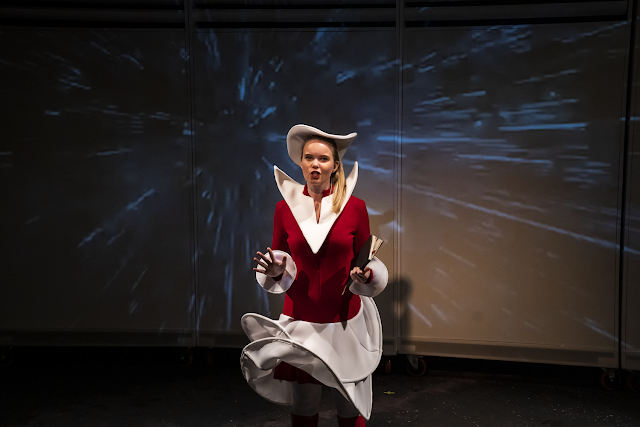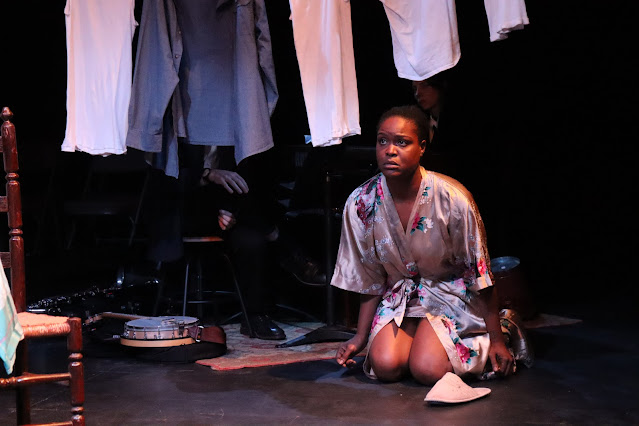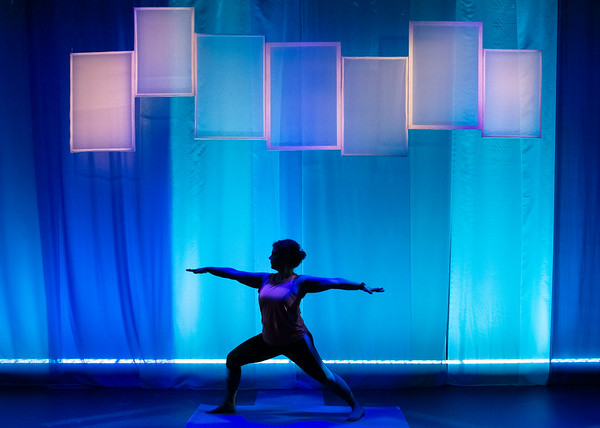ray gun say0nara
Written by Steven Mark Tenney
Directed by Janet Bentley
154 Christopher Street, Manhattan, NYC
December 4-22, 2019
 |
| Alexa Elmy. Photo by Al Foote III |
ray gun say0nara, Steven Mark Tenney's new "sci-fi play with songs" has evil twins, interstellar portals, immortal beings, and alien princesses, as well as rampant in-universe cosplay, cosmically significant proms, and, yes, ray guns. What we're saying is,
ray gun is a lot of fun. But its pulp sci-fi adventure trappings are also a conduit for themes about storytelling, mythologizing, and existential duality. Playing in repertory with
The Listening Room (reviewed by us
here) at New Ohio Theatre,
ray gun say0nara takes audiences on a retro-futurist journey to the stars in which dreams are as important as spacecraft and connection as important as conflict.
In the universe (or Metaverse) of
ray gun say0nara, aliens called Nadirians first came to Earth in the 1950s (a boom-time for the mainstreaming of sci-fi in our own world and the same era, the play points out, that TV made its arrival in our homes). The Nadirians secretly created an immortal being, a Celestial, meant to improve the Earth and imprisoned his evil twin, necessary to his creation, on a faraway planet under the guard of AI-equipped Automated Self-Driving Units and the sway of "fiction fields." It turns out, however, that there may have been a mix-up regarding which Celestial was placed where, and Captain Buck Law (Sean Leigh Phillips) has been dispatched to set things right. Meanwhile, the Sockets, consultant father Phil (Timothy Babcock), mother Millie (Laura Pruden), and son Billie (Sam Ogilvie), an archetypically 1950s white nuclear family, gets accidentally embroiled in these epic proceedings while merely trying to take their space vacation.
 |
| Timothy Babcock and Randall Rodriguez. Photo by Al Foote III |
When the Nadirians created an evil twin for good Celestial and student idol Brad Mayhem (Justy Kosek), they didn't do it just to make trouble. As the Sky Hop (Alexa Elmy; think space Pan Am hostess), who provides a substantial amount of the play's exposition, explains, the creation of the evil with the good is required (probably) by either karma or the law of conservation of energy. The twelve chapters, some announced as dreams, that make up ray gun are structured thematically around such complementary, inseparable binaries. Like the Celestials, for instance, the extraterrestrial Arc-Princesses, princesses who in the process of becoming, all exist "in dual." Such dualism inheres too in the play's mixture of technological and the mythic, in which fiction fields and poles of belief (the reversal of which every one thousand proms suggests a cyclical pattern as fitting for human narratives as for physics) exist alongside more expected science-fiction tropes, just as particles (or, here, persons) exist in quantum entanglement or matter exists alongside dark matter. In this universe, a trio of dancers (Ayaka Yoshimoto, Giorgia Riccardi, and Madisen Nielsen) simultaneously suggest retro-silvery aliens and the Fates, existential crises are more likely to be about what actually exists or not than about ennui, and cosplaying as media-amplified cultural figures such as Buck Mayhem enacts an unlimited number of doublings. The dialogue itself contains echoes, both in the atmospherically staged overlapping dialogue that introduces each section (some of these echoes are in Japanese, calling to mind the bilingual Sinophone/Anglophone future of Firefly, which similarly combines pulp adventure and science-fiction narratives) and in the subtle repetition of phrases and images.
 |
| Erin Grant, Ayaka Yoshimo, Sean Leigh Phillips, Rich Wisneski, and Joyce Miller. Photo by Al Foote III |
The cast pays homage to 1950s sci-fi melodrama by suffusing their performances with just the right amount of enjoyable kitsch. Babcock is very funny as the buttoned-down, out-of-his-depth family patriarch, and Phillips is excellent as the heroic Law, a mix of James Bond and Captain Kirk (or the valiant, square-jawed sci-fi protagonist of your choice) who is dressed like a mix of Bowie and Blade. Elmy's Sky Hop anchors the story with a professional smile that sometimes flashes an undercurrent of disquiet, and Melina Finck is unquestionably good as a Dragon Rider but even better as the dark version of the character Dynamo, possessed by a fragment of Brad Mayhem's evil twin and luxuriating in the potential to be bad. Joel Henry Little brings a suitable otherworldliness to Nadirian/crooner Holdon, while Kelsey Lea Jones's antagonist, the ASDU Lord, leader of the beings into which the Automated Self-Driving Units have evolved, is compelling and a pleasure to watch, making fantastic use of jerkily robotic movement. Indeed, there is great attention to movement in all aspects of
ray gun, including effective leaps into slow motion during a few crucial moments of action. The minimalist set, augmented with projections, proves effectively flexible, and while this is very much "a play with songs" rather than a musical, you may nonetheless find yourself humming some of playwright Tenney's tunes after you leave the theater.
Combining comedy, song, adventure, and metacommentary, ray gun say0nara uses familiar elements to create a universe that is entirely its own. According to the Sky Hop, people say that getting hit with a ray gun is dope as hell; getting hit with this ray gun certainly is.
-John R. Ziegler and Leah Richards






Comments
Post a Comment